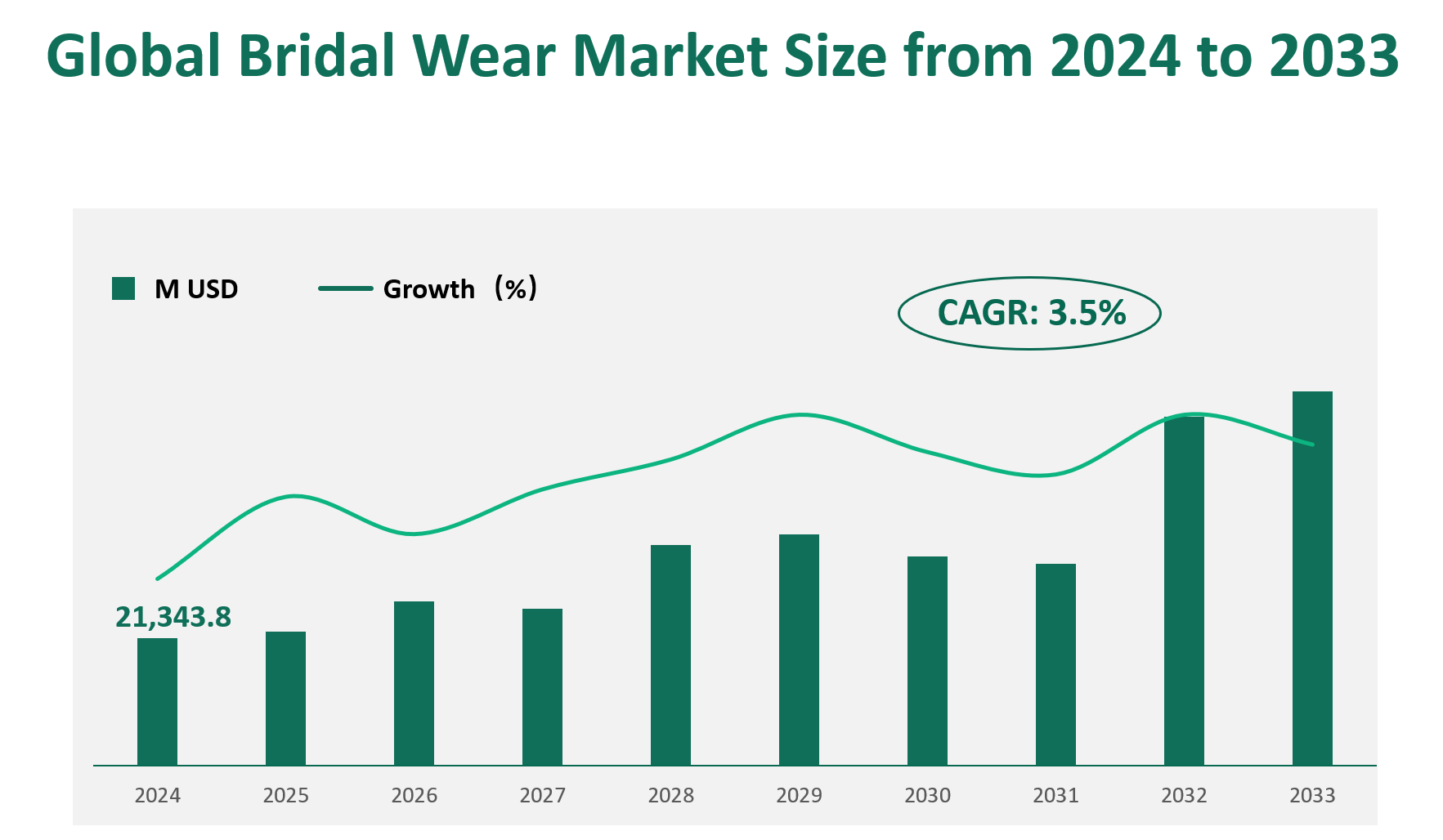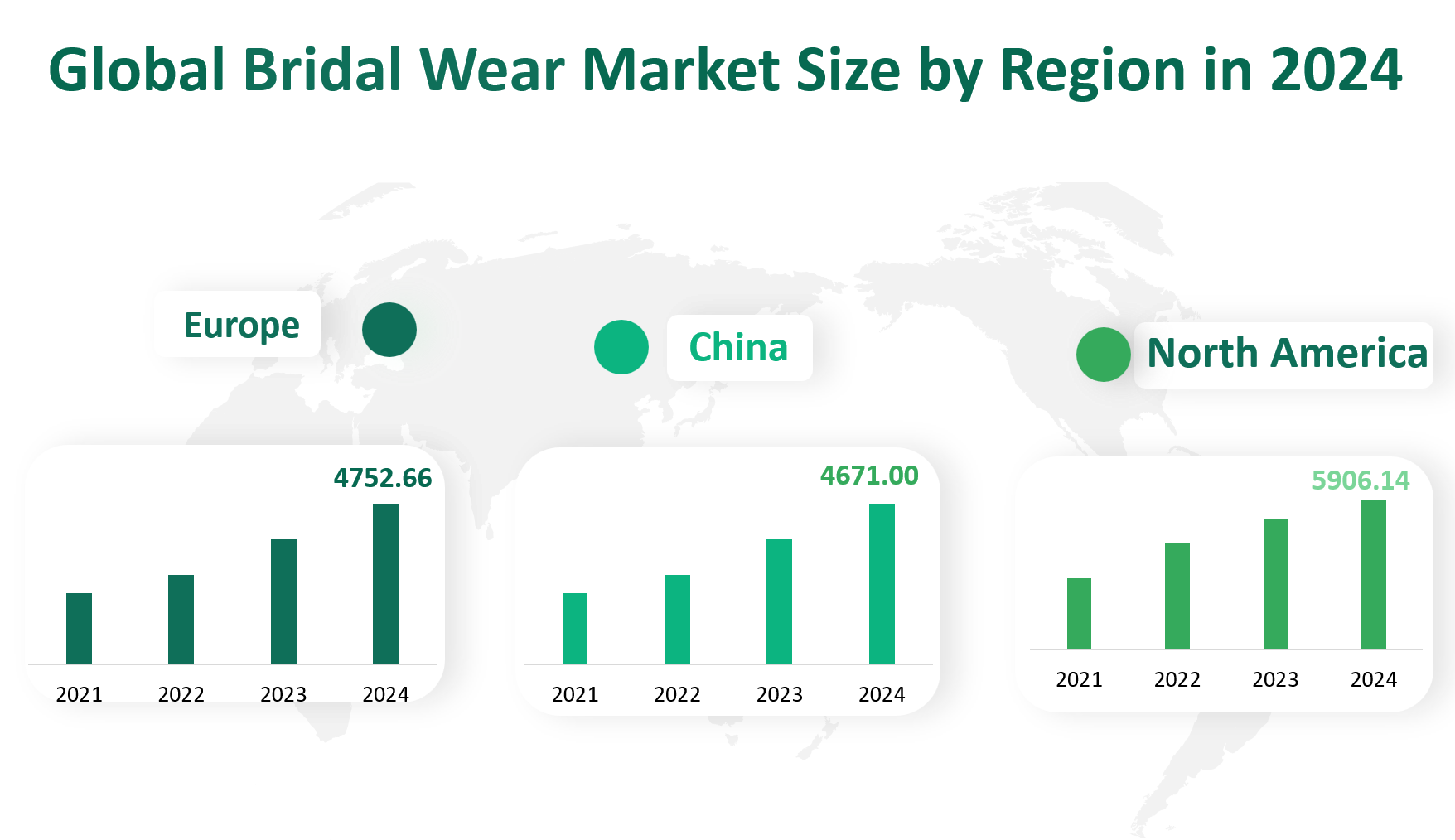1. Global Bridal Wear Market Insight Analysis
The global Bridal Wear market value is projected to reach approximately $21,343.8 million in 2024, with a Compound Annual Growth Rate (CAGR) of 3.5% over the next few years.
A wedding dress, also known as a bridal gown, is a garment traditionally worn by a bride during a wedding ceremony. The significance of the wedding dress varies across cultures and religions, but it generally symbolizes purity, love, and the beginning of a new life together. Modern bridal wear has evolved significantly, incorporating a wide range of styles, fabrics, and designs to cater to diverse tastes and preferences.
From classic satin and lace gowns to contemporary crepe and chiffon designs, the variety of materials and styles available reflects the dynamic nature of the industry. The market is highly competitive, with numerous players vying for market share. Major companies such as Pronovias Group, Vera Wang, and Monique Lhuillier are known for their high-quality, designer wedding gowns that cater to a global audience.
Figure Global Bridal Wear Market Size (M USD) and CAGR (2024-2033)

2. Driving and Limiting Factors of Bridal Wear Market Growth
The growth of the global Bridal Wear market is influenced by several key drivers and limiting factors. On the positive side, the increasing awareness of stylish and designer bridal gowns has significantly impacted the industry. Consumers are now more inclined to invest in high-quality, designer wedding dresses, driven by the desire to look their best on their special day. This trend has led to a surge in demand for sophisticated and diverse designs, prompting manufacturers to innovate and offer a wider range of personalized options.
Another significant driver is the rise of emerging markets, particularly in the Asia-Pacific region. Countries such as China and India have seen a rapid increase in the number of weddings, driven by a growing middle class and changing cultural norms. The demand for Western-style wedding gowns is also on the rise, further fueling market growth. Additionally, the increasing use of social media has provided brands with a powerful tool to reach a wider audience, driving brand visibility and consumer engagement.
However, the market also faces several challenges. One of the primary limiting factors is the availability of counterfeit products, which can harm the reputation of established brands and lead to lower sales and profits. The high cost of raw materials and rising labor costs also pose significant challenges for manufacturers. The wedding dress industry is labor-intensive, and increasing labor costs can lead to higher production expenses, which may be difficult to pass on to consumers.
Another limiting factor is the decline in marriage rates in many parts of the world. In countries like China and South Korea, the number of marriages has been steadily decreasing, which directly impacts the demand for wedding dresses. Additionally, the COVID-19 pandemic and regional conflicts, such as the Russia-Ukraine war, have disrupted supply chains and affected consumer behavior, leading to a temporary decline in market demand.
3. Technological Innovation and Corporate Mergers and Acquisitions in Bridal Wear Market
Technological innovation and corporate mergers and acquisitions are playing a crucial role in shaping the future of the Bridal Wear market. The industry is increasingly leveraging digital technologies to enhance the shopping experience for consumers. For example, many brands are investing in e-commerce platforms and digital marketing strategies to reach a broader audience. Augmented reality (AR) and virtual reality (VR) technologies are being explored to provide virtual try-on experiences and virtual showrooms, allowing customers to visualize how a dress would look without physically trying it on.
In addition to technological advancements, corporate mergers and acquisitions are also driving market consolidation. Major players are acquiring smaller brands to expand their product portfolios and strengthen their market positions. For instance, Pronovias Group, a leading global player in the bridal fashion industry, announced a significant recapitalization and strategic partnership in 2022. This move aimed to strengthen the company’s balance sheet and provide significant new funding for future growth.
4. Global Bridal Wear Market Size by Type
Tulle is a sheer, lightweight fabric with an open weave that often resembles a net. It is commonly used to create voluminous skirts, delicate overlays, and intricate details in wedding dresses. Tulle is popular for its ability to add a touch of elegance and sophistication to bridal gowns. In 2024, the market value of tulle is projected to be around 3312.30 million USD. This fabric is particularly favored for its versatility and ability to be used in various styles of wedding dresses, from classic to modern designs.
Satin is one of the most popular and versatile fabrics in the bridal wear industry. Known for its smooth finish and luxurious feel, satin is ideal for creating structured gowns with a refined, elegant look. It is often used for ruching, draping, and other design elements that add dimension and texture to the dress. The market value of satin in 2024 is estimated to be 5363.56 million USD. Satin’s durability and comfort make it a favorite among brides, contributing to its significant market share.
Lace is a delicate fabric characterized by its open mesh pattern, which can be created either by hand or machine. It is typically used as an overlay or detail on wedding dresses, adding a touch of romance and tradition. Lace comes in various styles, from intricate needle lace to more modern bobbin lace. In 2024, the market value of lace is forecasted to be 5513.34 million USD.
Chiffon is a lightweight, sheer fabric that is often used for its flowing, ethereal quality. It is commonly used in multi-layered skirts, sleeves, and overlays to create a soft, romantic look. Chiffon is also known for its slight stretch and slightly rough texture, which adds to its unique appeal. The market value of chiffon in 2024 is expected to be around 3052.31 million USD.
Crepe is a luxurious fabric that can be made from various fibers, including silk, wool, and synthetic materials. It is known for its beautiful drape and is often used in evening gowns and bridal wear. Crepe’s versatility makes it suitable for a wide range of styles, from formal to casual. The market value of crepe in 2024 is projected to be 1488.84 million USD.
Table Global Bridal Wear Market Size by Type in 2024
Market Size (M USD) 2024 | |
Tulle | 3312.30 |
Satin | 5363.56 |
Lace | 5513.34 |
Chiffon | 3052.31 |
Crepe | 1488.84 |
Others | 2613.45 |
5. Global Bridal Wear Market Size by Application
Wedding dress rental services offer a cost-effective alternative for brides who do not wish to purchase a wedding dress. These services provide a wide range of options, allowing brides to choose from various styles and sizes without the commitment of ownership. In 2024, the market value of wedding dress rental services is projected to be 4259.84 million USD.
Wedding consultants provide professional advice and guidance to couples planning their weddings. They often offer a range of services, including selecting the perfect wedding dress, coordinating with vendors, and managing the overall wedding planning process. The market value of wedding consultants in 2024 is estimated to be 1157.80 million USD.
Photographic studios play a crucial role in capturing the memories of a wedding day. They often provide a variety of services, including pre-wedding photoshoots, wedding day coverage, and post-wedding albums. In 2024, the market value of photographic studios is expected to be 2767.31 million USD.
Personal purchase refers to brides who buy a wedding dress directly for their own use. This is the most traditional and popular application in the bridal wear market. Personal purchase allows brides to own a unique and meaningful piece that they can cherish for years to come. In 2024, the market value of personal purchase is projected to be 13158.85 million USD.
Table Global Bridal Wear Market Size by Application in 2024
Application | Market Size (M USD) 2024 |
Wedding Dress Renting Service | 4259.84 |
Wedding Consultant | 1157.80 |
Photographic Studio | 2767.31 |
Personal Purchase | 13158.85 |
6. Global Bridal Wear Market by Top Regions
North America is a major market for bridal wear, characterized by a mature industry chain and a strong consumer base. In 2024, the market value in North America is projected to be around 5906.14 million USD. The region benefits from a robust economy, high disposable incomes, and a well-developed retail infrastructure. The United States, in particular, is a significant market, driven by a large number of weddings and a preference for high-quality, designer bridal wear.
Europe is another significant market for bridal wear, with a projected market value of around 4752.66 million USD in 2024. The region is known for its rich fashion heritage and high demand for luxury bridal gowns. Countries like France, Italy, and Spain are renowned for their bridal fashion designers and high-end boutiques. The European market is driven by a strong preference for traditional and elegant wedding styles, as well as a growing trend towards sustainable and eco-friendly bridal wear.
China is the fastest-growing market for bridal wear, with a projected market value of around 4671.00 million USD in 2024.
Japan is a significant market for bridal wear, with a projected market value of around 544.27 million USD in 2024.
Figure Global Bridal Wear Market Size by Region in 2024

7. Global Bridal Wear Market Analysis by Major Players
7.1 Pronovias Group
Company Introduction and Business Overview: Pronovias Group is a global leader in the bridal fashion industry, founded in 1964 and headquartered in Spain. The company operates a chain of bridal wear stores that offer a wide range of wedding dresses, cocktail dresses, veils, jewelry, shoes, and accessories. Pronovias is renowned for its elegant and sophisticated designs, catering to a global audience.
Products: Pronovias offers a variety of bridal gowns, including A-line silhouettes, princess gowns, and mermaid styles. Their collections often feature intricate beadwork, lace overlays, and luxurious fabrics.
Sales Revenue in 2023: 103.35 million USD.
7.2 FAMORY
Company Introduction and Business Overview: FAMORY is one of the top ten wedding and evening dress brands in the world, founded in 1956 and headquartered in China. The company specializes in high-end dresses, wedding gowns, lace, and various types of clothing. FAMORY is known for its exquisite craftsmanship and attention to detail.
Products: FAMORY offers a wide range of bridal wear, including single-neck designs, hand-sewn flowers, pearl grid yarn, and lace. Their products are characterized by their luxurious fabrics and intricate embroidery.
Sales Revenue in 2023: 61.15 million USD. FAMORY’s strong market presence in Asia, North America, and Europe contributes to its significant revenue in 2023.
7.3 Vera Wang
Company Introduction and Business Overview: Vera Wang is a renowned fashion designer and entrepreneur, founded in 1990 and headquartered in the United States. The company offers a wide range of bridal collections, including wedding dresses, bedding, eyewear, flowers, fragrances, and tabletop items. Vera Wang is known for her innovative designs and high-quality products.
Products: Vera Wang’s bridal collections feature a variety of styles, from classic to modern, with a focus on luxurious fabrics and intricate details. Her gowns often include unique elements such as lace overlays, beadwork, and innovative silhouettes.
Sales Revenue in 2023: 44.68 million USD.

